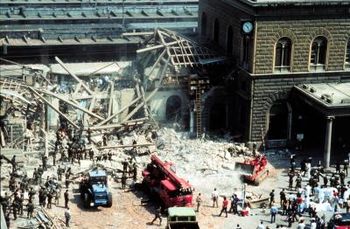سنوات الرصاص (إيطاليا)
| جزء من سلسلة عن |
| تاريخ إيطاليا |
|---|
 |
| التاريخ القديم |
| إيطاليا ما قبل التاريخ |
| الحضارة الإتروسكية (12م–6م. ق.م) |
| ماگنا گريشيا (ق. 8–7 ق.م.) |
| روما القديمة (ق. 8 ق.م.–5 م) |
| سيطرة القوط الشرقيين (القرون 5-6 ) |
| العصور الوسطى |
| إيطاليا في العصور الوسطى |
| اعادة فتح البيزنطيين لإيطاليا (قرون 6 -8) |
| سيطرة اللومبارد (6 –8 ح.) |
| الامبراطوريتان الكارولنجية والرومانية المقدسة |
| الإسلام والنورمان في جنوب إيطاليا |
| الجمهوريات البحرية والمدن-الدول الإيطالية |
| العصر الحديث المبكر |
| النهضة الإيطالية (ق. 14 –16) |
| الحروب الإيطالية (1494–1559) |
| السيطرة الأجنبية (1559–1814) |
| توحيد إيطاليا (1815–1861) |
| التاريخ الحديث |
| الملكية (1861–1945) |
| إيطاليا في ح.ع.1 (1914–1918) |
| الفاشية والامبراطورية الاستعمارية (1918–1945) |
| إيطاليا في ح.ع.2 (1940–1945) |
| الجمهورية (1945–الآن) |
| سنوات الرصاص (عقدا 1970–1980) |
| موضوعات |
| الدول التاريخية |
| التاريخ العسكري |
| التاريخ الاقتصادي |
| التاريخ الجيني |
| تاريخ المواطنة |
| تاريخ الموضة |
| التاريخ البريدي |
| تاريخ السكك الحديدية |
| تاريخ العملة |
سنوات الرصاص (إيطالية: Anni di piombo) هو تعبير يُستخدم للاشارة إلى فترة من الاضطراب الاجتماعي والسياسي في إيطاليا استمرت من أواخر الستينيات حتى مطلع الثمانينيات، واتسمت بموجة من حوادث الارهاب السياسي اليميني واليساري.
الحركة الماركسية الذاتية اليسارية في إيطاليا التي انخرطت في أحداث عدة في الفترة الممتدة من 1968 حتى نهاية السبعينيات. وتُعتبر سنوات الرصاص أنها بدأت بمقتل الشرطي أنطونيو أناروما الذي لقي مصرعه في مظاهرة يسارية في نوفمبر 1969، وتفجير پياتسا فونتانا في ديسمبر من ذلك العام، التي قتلت 17، وكلاهما في ميلانو.[1]
The term's origin possibly came as a reference to the vast number of bullets fired during the period,[2] or a popular 1981 German film Marianne and Juliane, released in Italy as Anni di piombo, which centered on the lives of two members of the West German militant far-left group فصيل الجيش الأحمر which had gained notoriety during the same period.
الاضطراب واسع النطاق في الستينيات والسبعينيات
There was widespread social conflict and unprecedented acts of terrorism carried out by both right- and left-wing paramilitary groups. An attempt to endorse the neo-fascist الحركة الاجتماعية الإيطالية (MSI) by the Tambroni Cabinet led to rioting and was short-lived.[3] Widespread labor unrest and the collaboration of countercultural student activist groups with الطبقة العاملة factory workers and pro-labor radical leftist organizations such as Potere Operaio and Lotta Continua culminated in the so-called "الخريف الساخن" في 1969, a massive series of strikes في المصانع والمراكز الصناعية في شمال إيطاليا.[1] Student strikes and labor strikes, often led by leftist or Marxist activists, became increasingly common, often deteriorating into clashes between the police and demonstrators composed largely of students, workers, activists, and often left-wing militants.[1] كان للديمقراطيين المسيحيين (DC) دوراً محورياً في حصول الحزب الاشتراكي الإيطالي (PSI) على السلطة في الستينيات وخلقواً تحالفاً معه. اغتيال زعيم الديمقراطيين المسيحيين ألدو مورو in 1978 ended the strategy of historic compromise بين الديمقراطيين المسيحيين و الحزب الشيوعي الإيطالي (PCI). الاغتيال قامت به الألوية الحمراء، التي كان يقودها حينئذ ماريو مورِتي. بين 1969 و 1981، يُعزى نحو 2,000 قتل إلى العنف السياسي في شكل تفجيرات واغتيالات وقتال الشوارع بين الفصائل المسلحة المتخاصمة.
تأريخ
1969
1970
مولد الألوية الحمراء
1978
اختطاف واغتيال ألدو مورو
1979
السنة الأكثر اغتيالاً
1980
المزيد من الاغتيالات
مذبحة بولونيا
اللجوء
فرنسا
البرازيل
بعض المواطنين الإيطاليين المتهمين بأعمال ارهابية حصلوا على لجوء في البرازيل مثل Cesare Battisti and others former members of the Armed Proletarians for Communism, a far-left militant and terrorist organization.
نيكاراگوا
بعض الناشطين اليساريين الإيطاليين حصلوا على لجوء سياسي في نيكاراگوا، ومنهم Alessio Casimirri، الذي شارك في اختطاف ألدو مورو.
المنظمات الارهابية في إيطاليا (قائمة غير كاملة)
- الألوية الحمراء
- Prima Linea
- Gruppo XXII Ottobre
- Ordine Nuovo
- الطليعة الوطنية (إيطاليا)
- Nuclei Armati Rivoluzionari
انظر أيضاً
الهامش
- ^ أ ب ت Montanelli, Indro; Mario Cervi (1991). L'Italia degli anni di piombo. Milan, Lombardy, Italy: Rizzoli Editore.
- ^ Westcott, Kathryn (January 6, 2004). "Italy's history of terror". BBC News.
- ^ Montanelli, Indro; Mario Cervi (1989). L'Italia dei due Giovanni. Milan, Lombardy, Italy: Rizzoli Editore.
ببليوگرافيا
- Montanelli, Indro; Mario Cervi (1989). L'Italia dei due Giovanni. Milan, Lombardy, Italy: Rizzoli Editore.
- Montanelli, Indro; Mario Cervi (1991). L'Italia degli anni di piombo. Milan, Lombardy, Italy: Rizzoli Editore.
- Zavoli, Sergio (1992). La notte della repubblica. Rome, Lazio, Italy: Nuova Eri.
- Montanelli, Indro; Mario Cervi (1993). L'Italia degli anni di fango. Milan, Lombardy, Italy: Rizzoli Editore.
- Cento Bull, Anna; Adalgisa Giorgio (2006). Speaking Out and Silencing: Culture, Society and Politics in Italy in the 1970s.
- Fasanella, Giovanni; Giovanni Pellegrino. La guerra civile.
- Per le vittime del terrorismo nell'Italia repubblicana – Istituto Poligrafico e Zecca dello Stato Libreria dello Stato – Istituto Poligrafico e Zecca dello Stato S.p.A. The office of Republic President.
وصلات خارجية
- Chronology of the Years of Lead (Italian)
- الحكومة الخفية لإيطاليا، Rosella Dossi, CERC (Contemporary Europe Research Centre, جامعة ملبورن)
- جميع الصفحات التي تحتاج تنظيف
- مقالات بالمعرفة تحتاج توضيح from November 2016
- Portal-inline template with redlinked portals
- Pages with empty portal template
- Sidebar using too many parameters
- Articles containing إيطالية-language text
- Pages using Lang-xx templates
- التاريخ الحديث لإيطاليا
- سنوات الرصاص (إيطاليا)
- عقد 1970 في إيطاليا
- عقد 1980 في إيطاليا
- ارهاب شيوعي
- ارهاب فاشي جديد
- حروب بالوكالة
